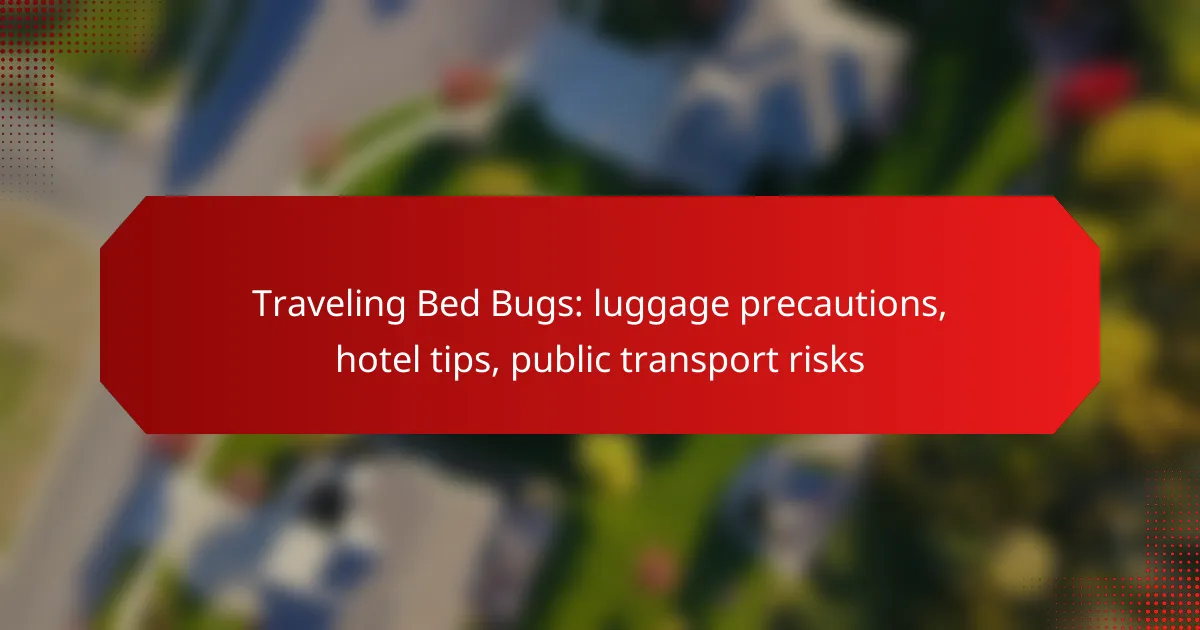Traveling can expose you to bed bugs, making it essential to take precautions with your luggage and accommodations. By using protective covers, inspecting your bags, and being vigilant in hotels, you can significantly reduce the risk of bringing these pests home. Additionally, understanding how to identify signs of bed bugs and knowing what to do if you encounter them can help safeguard your travel experience.

What precautions should I take with luggage to avoid bed bugs?
To avoid bed bugs while traveling, take proactive measures with your luggage. This includes using protective covers, inspecting your bags, storing them properly, and keeping them closed when not in use.
Use protective luggage covers
Protective luggage covers act as a barrier against bed bugs. These covers can be made from materials that are difficult for bed bugs to penetrate, providing an extra layer of security during your travels.
When selecting a cover, look for one that fits snugly over your luggage and is easy to clean. This will help ensure that any potential bugs are contained and can be removed easily if necessary.
Inspect luggage before and after travel
Before packing, inspect your luggage for any signs of bed bugs, such as small dark spots or shed skins. This can help you catch any issues before they become a problem during your trip.
After returning home, check your luggage again before bringing it inside. This double-checking can prevent bed bugs from entering your living space and infesting your home.
Store luggage on hard surfaces
When in hotels or other accommodations, store your luggage on hard surfaces like tables or countertops instead of on beds or carpets. Hard surfaces are less likely to harbor bed bugs compared to soft furnishings.
If possible, keep your luggage elevated on a luggage rack. This reduces the risk of bed bugs climbing into your bags from the floor or surrounding areas.
Keep luggage closed when not in use
Keep your luggage closed when you are not actively using it. This simple step minimizes the chance of bed bugs crawling into your bags while they are unattended.
Consider using packing cubes or zippered bags for your clothing and personal items inside your luggage. This adds an additional layer of protection and makes it harder for bed bugs to access your belongings.

How can I identify bed bugs in hotels?
To identify bed bugs in hotels, look for signs of their presence in common areas such as beds, furniture, and carpets. Early detection can help prevent infestations in your luggage and home.
Check mattress seams and headboards
Start your inspection by examining the seams of the mattress and the headboard. Bed bugs often hide in these areas, so pull back the bedding and look closely for any signs of the pests.
Use a flashlight to illuminate dark corners and crevices. Pay attention to any unusual stains or discoloration, which may indicate bed bug activity.
Look for dark spots or shed skins
Dark spots, often resembling small ink stains, can indicate bed bug excrement. These spots are typically found on sheets, mattresses, and nearby surfaces.
Shed skins, or exoskeletons, are another telltale sign. Bed bugs molt several times as they grow, leaving behind these skins in their hiding spots.
Inspect furniture and carpets
Bed bugs can also inhabit upholstered furniture and carpets. Carefully inspect seams, folds, and any hidden areas where they might conceal themselves.
Check behind and beneath furniture, as well as along baseboards and in carpet edges. If you notice any signs of bed bugs, consider changing rooms or finding alternative accommodations.

What should I do if I find bed bugs in my hotel room?
If you find bed bugs in your hotel room, act quickly to minimize any potential bites or infestations. Notify the hotel staff, request a room change, and document the issue to ensure your concerns are addressed properly.
Notify hotel management immediately
As soon as you discover bed bugs, inform the hotel management without delay. This allows them to take immediate action, such as inspecting the room and addressing the issue with pest control. Prompt notification can help prevent the problem from affecting other guests.
When notifying management, be clear about your findings and express your concerns. This will help them understand the urgency and seriousness of the situation.
Request a room change
After reporting the issue, ask for a room change. Ideally, the new room should be in a different part of the hotel to reduce the risk of encountering the same problem. Ensure that the new room is thoroughly inspected before you move in.
When switching rooms, check for signs of bed bugs, such as small dark spots or shed skins, to ensure your new accommodation is free from pests.
Document the issue with photos
Take clear photographs of any bed bugs or signs of their presence, such as bites on your skin or evidence on the bedding. This documentation can be crucial if you need to file a complaint or seek compensation later.
Keep a record of your communication with hotel management, including dates and times. This information may be helpful if the situation escalates or if you need to provide evidence of your experience.

What are the risks of bed bugs on public transport in the UK?
Bed bugs pose a significant risk on public transport in the UK, as they can easily hitch a ride on passengers and their belongings. These pests thrive in crowded environments, making buses and trains potential hotspots for infestation.
Potential for infestation in buses and trains
Buses and trains provide ideal conditions for bed bugs to spread due to the close proximity of passengers. Infestations can occur when an infested person sits down, allowing the bugs to move to nearby seats or luggage. Regular cleaning and inspections are crucial to minimize these risks.
Transport operators are increasingly aware of the problem and may implement pest control measures. However, passengers should remain vigilant and take precautions to avoid bringing bed bugs home.
Increased exposure during peak travel times
During peak travel times, the risk of encountering bed bugs on public transport increases significantly. Crowded conditions allow for easier transmission of these pests from one passenger to another. This is particularly true during rush hours or major events when public transport is heavily utilized.
To reduce exposure, consider traveling during off-peak hours when possible. If you must travel during busy times, be mindful of your surroundings and avoid placing bags on the floor or adjacent seats.
Common hiding spots in seats and luggage racks
Bed bugs often hide in seams, crevices, and folds of seats, as well as in luggage racks. They can easily go unnoticed, making it essential for passengers to inspect their seating area before settling in. Look for small dark spots or shed skins as indicators of an infestation.
When using public transport, keep your belongings close and avoid placing them on the ground. Consider using protective covers for your luggage and inspect it regularly to prevent bringing bed bugs home.

How can I protect myself from bed bugs while using public transport?
To protect yourself from bed bugs while using public transport, take proactive measures such as avoiding contact with surfaces where these pests may reside. Being vigilant and following specific guidelines can significantly reduce the risk of bringing bed bugs home.
Avoid placing bags on the floor
Keeping your bags off the floor is crucial in preventing bed bug exposure. Use overhead compartments or place your belongings on your lap instead. If possible, consider using a bag with a hard bottom that can be placed on a seat rather than directly on the floor.
Many public transport systems have high foot traffic, making it easier for bed bugs to hitch a ride on bags placed on the ground. By avoiding floor placement, you minimize the chances of contact with these pests.
Inspect seating areas before sitting
Before taking a seat, conduct a quick inspection of the area for any signs of bed bugs. Look for small dark spots, which may indicate bed bug droppings, or any visible insects. If you notice anything suspicious, choose another seat or even a different vehicle if possible.
Pay special attention to seams and crevices in the upholstery, as bed bugs often hide in these areas. A thorough check can help you avoid an uncomfortable and potentially costly situation.
Keep belongings close and monitored
Always keep your belongings within sight and reach while using public transport. This not only helps you keep track of your items but also allows you to notice any unusual activity around your bags. If you see someone or something suspicious, be prepared to move your belongings to a safer location.
Consider using a lock or a secure bag that can be fastened to your seat. This added layer of security can deter potential pests and help you maintain control over your items during your journey.

What are the signs of a bed bug infestation?
Signs of a bed bug infestation include visible bugs, shed skins, and small blood stains on bedding. Recognizing these indicators early can help prevent a larger problem.
Itchy bites on exposed skin
One of the most common signs of bed bug presence is itchy bites on exposed skin. These bites typically appear in clusters or lines and can cause significant discomfort, leading to scratching and potential secondary infections.
Bed bug bites often resemble mosquito bites but may take a few days to show up. If you notice unexplained itchy welts after staying in a hotel or using public transport, it’s wise to inspect your belongings and sleeping areas for further signs of infestation.
To minimize the risk of bites, consider wearing long sleeves and pants when traveling, especially in areas known for bed bug issues. Additionally, applying insect repellent can provide an extra layer of protection against these pests.
